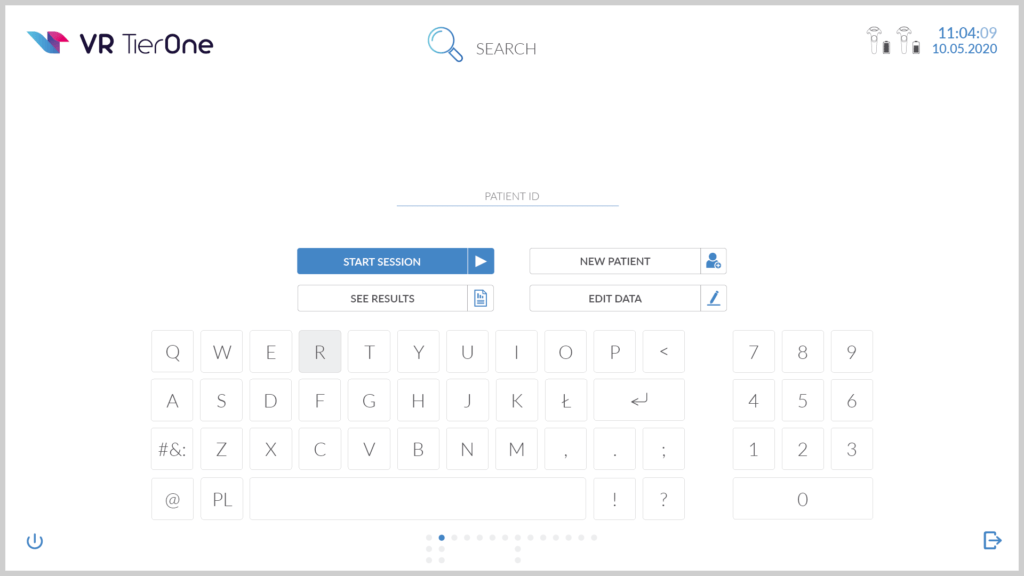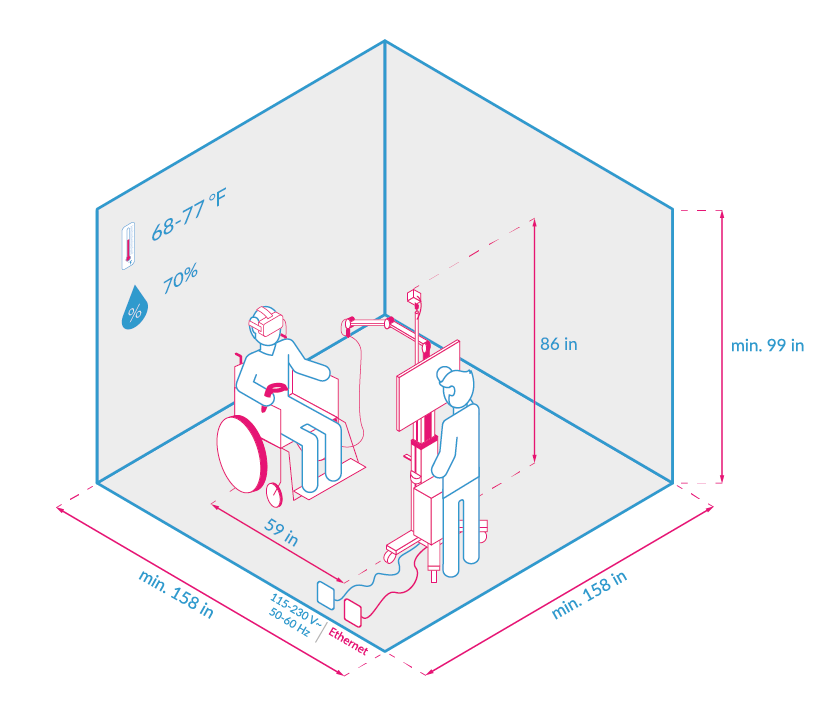VR TierOne technically
1. What is Virtual Reality?
Virtual Reality (VR) is a 3D world created with the use of computer technology, either resembling closely the real world, or presenting an image of another, fictional environment. In other words, it is a generated environment in which we can completely immerse ourselves.
2. What does the VR TierOne solution involve?
VR TierOne is a therapeutic story conveyed to the patient using the latest technology – Virtual Reality. It consists of eight therapeutic sessions – with each lasting about 20 minutes.
3. How can one enter the world of Virtual Reality?
To do this, we have to use our solution: VR TierOne, it consists of a special VR headset that displays a three-dimensional (3D) image, and after we put it on, it isolates us completely from the elements of the outside world.
4. How exactly does the VR TierOne work?
VR TierOne brings the patient in a special created virtual space and provides strong positive therapeutic suggestions, which improve the patient’s mood and reduce the level of anxiety, increasing hope for improvement and strengthening the motivation for rehabilitation.
5. What does the VR TierOne therapeutic solution consist of?
The VR TierOne designed by us consists of two parts: a medical VR device and a therapeutic cycle – the therapeutic cycle was uploaded to the device.
6. How complicated is the installation of the VR TierOne device?
The device is designed as a “plug and play” system, so after plugging it in, you can launch it with a single button. The device does not require calibration. It takes just several minutes to learn how to use it – we have created it in such a way that it is very easy to use.
7. Has the VR TierOne therapeutic solution been subject to scientific research?
Yes. The device has been successfully tested and proven to be effective. Additionally, VR TierOne is a medical device. Details of scientific research can be found in the SCIENTIFIC RESEARCH tab of this website.
8. What do GDS, PSQ and HADS, that were all quoted in the research section, stand for?
GDS, PSQ and HADS are measurement tools applied in research on the effectiveness of the VR TierOne solution in the area of depression, stress and anxiety reduction. You will find further details of each of them below.
GDS (Geriatric Depression Scale) is a scale for assessing depression in the elderly designed in the 1980s. The creator of the Geriatric Depression Scale is Jerome Yesavage a geriatric psychiatrist from California. GDS helps diagnose depression in people during their autumn years. The scale consists of 30 questions which can be answered either “yes” or “no”. The maximum GDS score is 30 points. Using the scale, we can diagnose: no depression, mild depression and severe depression. The application of the reliable GDS research tool allowed us to conclude that in patients undergoing rehabilitation with the use of VR TierOne, the symptoms of depression were reduced by 37%.
PSQ (Perception of Stress Questionnaire) is the research tool created by professors Mieczysław Plopa and Ryszard Makarowski. The Polish tool is based on the 1980s PSQ by an American doctor practicing in Italy – Dr. Susan Levenstein. The PSQ questionnaire consists of 27 statements relating to the areas of external stress, intrapsychic stress and emotional tension. The examined persons determine the degree to which a given statement applies to them. The higher score in the PSQ the higher the perceived stress level. The questionnaire study was conducted before and after the intervention with the use of VR TierOne. The use of the PSQ tool in research on the effectiveness of VR TierOne allowed to discover a decrease in the level of stress in patients by 28%.
HADS (Hospital Anxiety and Depression Scale) is the tool created in the 1980s by British psychiatrists. The scale consists of 14 items, half of which are related to anxiety and half to depression. It is an established research tool, commonly applied by physicians to determine the level of anxiety and depression in a patient. The questionnaire is intended for self-completion by the patient. It is precisely constructed – a concise and understandable measurement tool for the patient and a convenient measuring tool for the researcher. It takes 2-5 minutes to complete the questionnaire. The HADS assessment performed after VR TierOne intervention demonstrated a 37% decrease in patients’ anxiety.
9. How can you learn to use the VR TierOne portal?
The set includes an instruction manual. It is a step-by-step explanation of how to operate the VR TierOne device. Its operation is intuitive, the therapeutic session for the patient is initiated via the touch activated interface. Our staff will conduct training after purchasing the device. If you are a patient who wants to take advantage of VR TierOne therapy, you do not have to worry about anything – the medical staff will start a therapeutic session for you.
10. Is the VR TierOne device difficult to operate?
The device interface is extremely clear and intuitive. Even people with no experience in the use of medical devices and computers, whatsoever, have no problems with using it. The device is started and stopped with a single button.
11. What does the interface of the VR TierOne device look like?
Touchscreen user interface, sample screen:

12. Where can I buy the VR TierOne therapy device?
We are the manufacturer of VR TierOne solution. You can buy the device directly from us. All you have to do is leave us your details by filling out the contact form at the Contact page. We will contact you as soon as possible and arrange a convenient presentation date. We can meet or introduce the device to you also during an online video presentation.
13. What is the price of the VR TierOne device?
The gross price is USD 20 500.
14. What is the warranty period for the VR TierOne device?
The warranty period is 12 months.
15. Can the warranty be extended?
The warranty period can be extended to cover another 12 months for an additional fee of EUR 1650 gross (the price includes 23% VAT).
When buying a new device, the price of the 12-month warranty is EUR 1400 gross (the price includes 8% VAT).
Please remember to extend the warranty 6 months before the end of the current warranty period.
16. What media should be provided for the device to work?
The VR TierOne device requires access to electricity (115-230V, 50-60Hz) and, optionally, Internet connection (Ethernet RJ-45 cable connection).
17. How many languages is the manual available in?
The device comes with a manual in three languages: English, German and Polish.
18. What is the mass of the VR TierOne device?
The VR TierOne device weighs 35 kg.
19. Does the device produce sound?
Yes. Thanks to VR headsets, the patient receives visual stimuli with the help of goggles, and the auditory stimuli – i.e. spatial sound – with use of headphones. Thanks to the involvement of both senses, the patient is more easily subjected to the phenomenon of total immersion.
20. What room size do I require to freely install a VR TierOne portal in it?
The minimum requirements for the room are: height 99 in, width 158 in, length 158 in.

21. What are the other parameters of the VR TierOne device?
The screen diagonal size of the monitor is ~ 24 inch, the height of the device is 86 in, the width is 0.91 m, the length is 36 in, the arm range is 40 in, the length of the power cable is 197 in.
22. How to care for the VR TierOne device correctly?
Proper care and removal of any dirt or soiling will enable you to prevent device failure. Regular care of the components, by keeping them clean allows you to check the condition of the device and maintain its efficiency and safety.
Caring for the VR headset:
- Never grab or lift the headset by the transmission cable.
- Protect the goggle lenses from scratching.
- Protect the goggle lenses from exposure to sunlight.
- Wipe the optics of the goggles with moist cleaning wipes.
- Use goggle adjustments – knobs and straps, do not use force solutions.
- After the session is over, hang the goggles on the dedicated hanger at the VR portal.
- Use disposable hygienic masks under the VR goggles, they protect users and prevent the inside of the goggles from getting dirty with makeup and sweat.
- The soft cover inside the goggles can be removed and cleaned under running water. Dry the cover before reassembling.
Caring for the VR headset cable:
- Do not bend the goggles data cable, a possible break is dangerous.
- Do not let the hanging part of the VR headset cable located outside the slide arm guide twist or bend.
Taking care of the device/VR portal:
- Always operate the device with clean, dry hands.
- Remove dirt from the device using a damp cloth.
- Do not use detergents for cleaning, do not pour water on the device.
- To prevent overheating of components, do not block ventilation ports.
- Keep the virtual therapy room clean.
- Avoid relocating the VR TierOne device when cleaning the room.



